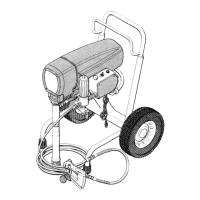‘ROBLEM
1 CAUSE
[ SOLUTION
AI. Not enough paint pressure (See Pro-
1. Pressure setting too low
1. Increase.
blem III also.)
2. Spray tip too big or worn
2. Change tip; see manual 307321.
3. Motor brushes worn
3. Replace. See page 14.
4. Pressure control or motor
4. Return for repair.
damaged
‘Ill. Poor spray pattern
1. Clogged spray tip
2. Pressure setting too low
3. Outlet filter or hose partially
clogged
4. Spray tip too big or worn
5. Paint supply low or pail empty
6. Paint too thick
1. Clean. See manual 307321.
2. Increase.
3. Clean; see manual 367-273.
4. Change tip; see manual 307-321.
5. Fill; reprime to remove air.
6. Thin per paint manufacturer’s
recommendations.
IX. Spitting from spray gun
X. Static sparking from gun
1. Paint supply low or pail empty
2. Sprayer sucking air or gun
needle not seating
1. Sprayer or work not grounded
1. Fill, reprime to remove air.
2. Tighten fittings; repair gun; see
manual 307-614.
1. Check hose continuity and elec-
trical ground connection.
(a) Engage gun safety latch, Depress manual reset button on top of pressure control. If the sprayer continues to shut
off,
reduce
spraying pressure. If the problem isn’t corrected, return for repair.
(b) Freezing results from failure to replace water-base paint or flushing water with mineral spirits at shutdown.
(cl Overpressurization results from (1) using less than 50 ft (15.2 m) of nylon spray hose; (2) using wire braid hose: (3) adding a
shutoff device between filter and main hose; (4) plugging the main fluid outlet of the filter and using drain valve as a shutoff; and
(51 a clogged or incorrectly assembled filter.
(d) EIIesr;z to keep packing nut l/3 full of Throat Seal Liquid to help prevent premature wear of throat packings and paint drying on
DISPLACEMENT PUMP REPAIR
Tools Needed:
Heavy duty vise
718” open end wrench
2’ open end wrench
Plastic mallet
Small screwdriver
Before doing this
procedure, follow the Pressure
Lh:yNG-i
Relief Procedure Warning on page 14 to reduce
the risk of an injection injury, injury from moving
Removina the Puma
(Refer to Fia 8.1
1.
2.
3.
4.
5.
Flush the pump,‘if possible, &d relieve pressure
again. Stop the pump with the piston rod (223) in
its lowest position.
Unscrew the suction tube (42) from the pump. Hold
the
wrench on the pump intake valve (222) to keep
the pump from loosening.
Unscrew the hose (47) from the nipple (48) on the
pump outlet and remove the hose.
Use a screwdriver to push the retaining spring (35)
aside and push out the pin (20).
Loosen the locknut (38) and unscrew the pump
from the bearing housing (27).
Fig 8
307-643 15

